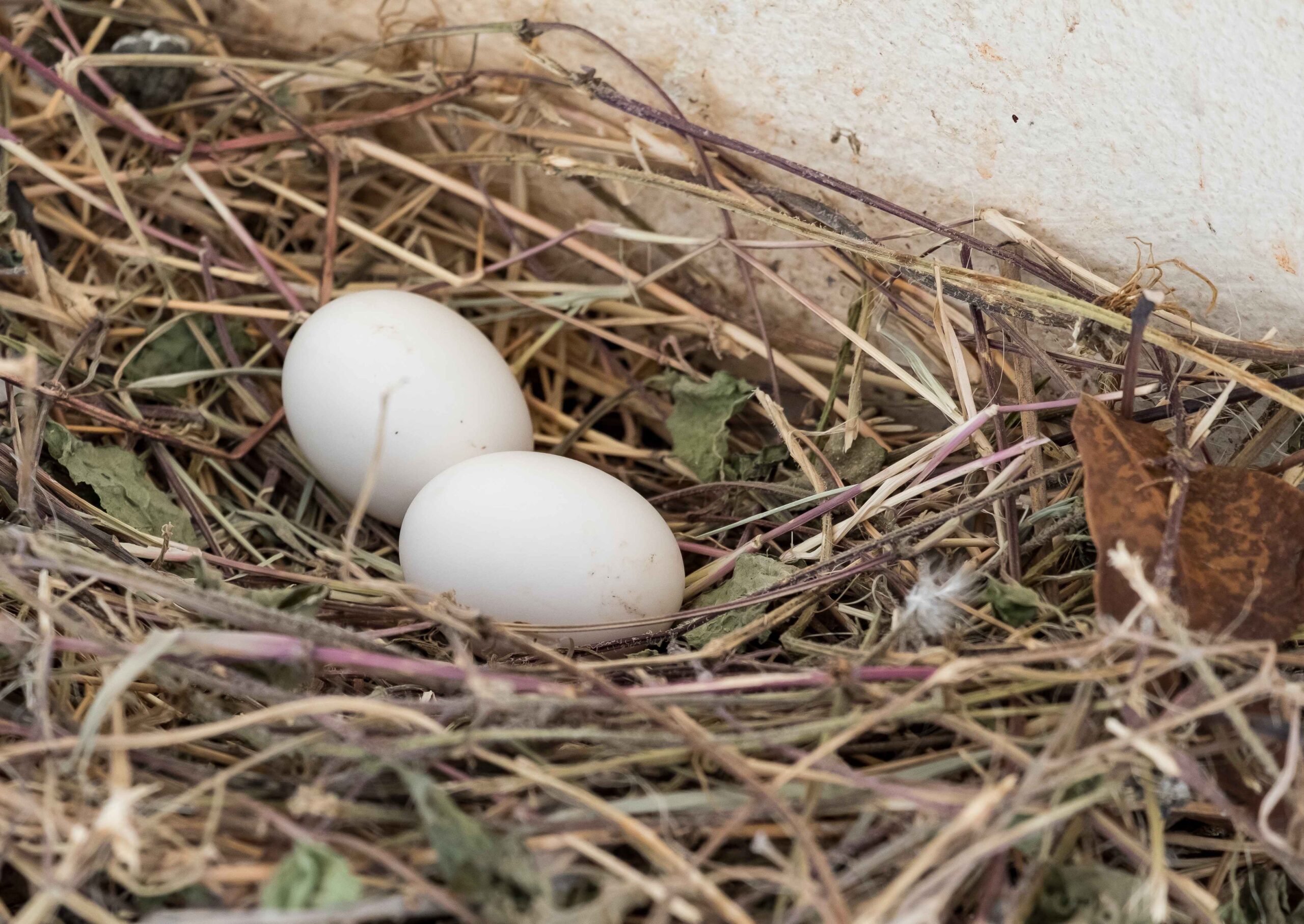Gratitude abounds during Burial of Ashes
University, community and family members gave thanks to body donors during annual interment ceremony
When Michelle Clyne was little, her father, Henry “Hank” Clyne, had her convinced that he hunted dinosaurs. When she’d draw pictures of his grand adventures, her teacher would say what a great imagination she had.

To the Chicago resident who flew to San Antonio to attend UT Health San Antonio’s Burial of Ashes ceremony to inter the cremated remains of those who gave their bodies for student education and to pay tribute to the donors, the event provided a special opportunity to honor her father’s memory.
“I was not expecting to be this emotional, since it was three years ago that he passed, but this was the closest to a funeral that I was able to experience,” Clyne said.
Clyne, along with her sister, Jenni Stewart, and brother, David Clyne, recalled the beautiful details that made their father who he was. His great mustache. His love of broccoli cheddar soup. His compassion for animals. His sweet, gentle demeanor. His love of science and teaching.
“I’m a teacher, and he used to come to my classroom to teach how the planets rotate around the sun,” Stewart recalled. “And he did it for us kids when we were little with a flashlight and a basketball.”
The Clynes were among about 150 people who attended the interment ceremony at UT Health San Antonio’s Memorial Park on April 29. Attendees included donor family members and the university’s faculty, staff and students, who expressed their gratitude for the donors’ important contributions toward educating students.
Honoring donors’ generous, selfless contributions
The ceremony began with music, including an instrumental quartet composed of first-year medical students from the university’s Music and Medicine group, followed by a vocal performance by graduate students from The University of Texas at San Antonio’s Vocal Music Department and department chair John Nix, and rounded out with a rendition of “Amazing Grace” by internationally recognized bagpiper Robert Chalk. Chalk has participated in the event since 2004. He served as the supervisor of anatomical services for UT Health San Antonio’s Body Donation Program before moving to the University of the Incarnate Word’s School of Osteopathic Medicine as director of UIW’s Willed Body Program.

While Sandesh Puri, a first-year medical student and a member of the Music and Medicine group, did not perform during the event, he felt compelled to attend to pay tribute to the donors.
“I really wanted to come to this event to pay my respects and share and show my gratitude for all the families that have given us the opportunity to learn,” Puri said.
Omid B. Rahimi, PhD, professor and director of the Human Anatomy Program at UT Health San Antonio’s Department of Cell Systems and Anatomy, welcomed the attendees and expressed appreciation to the donors’ family members.
“This ceremony reflects our profound gratitude and respect for all the participants in our body donation program and conveys our appreciation for the compassion and support of their family and friends, regardless of occupation, social standing, age, health or ailment,” Rahimi said. “Each donor’s remarkable gift equally contributes in shaping the well-being of future generations.”
Following Rahimi’s introduction, Lily Q. Dong, PhD, professor and chair, Department of Cell Systems and Anatomy, and Sadie A. Trammell Velasquez, MD, FACP, associate professor of medicine and assistant dean for the preclinical curriculum in the Office of Undergraduate Medical Education, paid tribute to the donors along with seven representatives from classes that have studied anatomy in the past year.
Students express their heartfelt gratitude
First-year occupational therapy student and class president Catherine Buley eloquently recalled her reverence for the donors.

“Before we ever stepped into the lab, our professor reminded us that these bodies were to be treated with the utmost respect,” Buley said. “I expected to feel overwhelmed, maybe even cry, but when I finally entered the lab and saw the donor we would be learning from, what I felt instead was a deep sense of humility and compassion. Over the semester, that feeling only grew. This person became more than a learning tool. They became a kind of silent teacher, almost like a companion. In every layer we studied, they shared something of themselves with us.”
Buley shared that for her and her classmates, the body donors not only deepened their understanding of the human form, but also taught them how to apply their class experience to the complexities of real people.
“In occupational therapy, we don’t just treat injuries or limitations, we treat people and we help them return to the things that make life meaningful like dressing, cooking, holding a grandchild, returning to work,” Buley said. “These donors reminded us that every body holds a lifetime of these moments. They helped us understand not only how bodies move, but why it matters that they do.”
“To the families here today, you gave not only the gift of a body to science, but the gift of trust to us as learners.” — Catherine Buley, first-year occupational therapy student
First-year dental student and class president Kate McNeill said the donors provided a gift that would contribute to her classmates’ futures by becoming their very first teachers in the study of anatomy.
“One student shared a sentiment that a lot of us related to on how they imagined who their donor might have been, what their favorite food was, what their laughter sounded like, and what memories they held dear,” McNeill said. “It reminded us constantly that the individuals had full, rich lives. … These thoughts shaped the way we approach each lesson, not with detachment, but with a growing sense of connection and empathy. There were times we found ourselves offering a quiet thanks before beginning our work or pausing for a silent moment at the end of a long day — gestures of gratitude that became part of our routine, just as essential as any scientific method. These small rituals helped us to stay grounded in the humanity of what we were experiencing, even as we learned the technical skills that would carry us forward into our future professions.”
First-year medical student and class president Aadil Rehan thanked the families and expressed his gratitude for the donors, who by giving their bodies to the study of medicine, have provided the next generation of doctors an “irreplaceable component” of their education.
“Whenever I have doubted myself, I remember that our donors chose to believe in us so strongly that they dedicated their bodies to our betterment, and in turn, the betterment of so many in the future,” Rehan said. “In that sense, even after biological life ends and the physical body fades, those who pass on remain with us through their memory, their actions, their legacy. … And while our time with the donors was brief, they have irrevocably shaped us on our path to becoming physicians. Every life that we touch will be a testament to the opportunity our donors gave us. … Perhaps our greatest teachers are those whose voices we will never get to hear.”
For Elizabeth Arnold, a second-year medical student at UIW’s School of Osteopathic Medicine, the opportunity to see the families of the donors and express her gratitude was special. She was among the students to provide remarks at the event, as UT Health San Antonio’s Body Donation Program provides body donors for study at UIW.
“I think it just really drives home the humanity aspect of our professions, getting to meet the people who lived with and resided beside their [loved ones their] entire life, and we are now able to learn from that person,” Arnold said. “So, just being able to have a ceremony where we get to see the family members is very important.”
Following the speakers, family members solemnly walked past the gravesites marking the donations of previous years and placed a red flower or a handful of dirt to pay their respects.
Embracing treasured memories
For Theresa Smith, attending the ceremony sparked memories of her big brother, Andrew Hildebrand, who left for Germany to serve in the U.S. Air Force when she was a child.
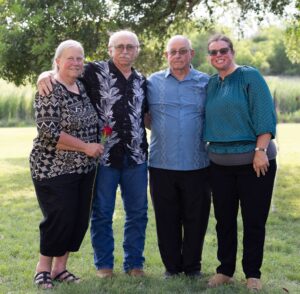
“We had gone to the airport [to see him off and the memory] is very vivid,” she recalled. “I was four or five years old.”
She smiled warmly as she recalled her brother, who she described as a quiet, generous soul who always thought of others.
Smith’s brother, William Hildebrand, said their brother Andrew — the second oldest of nine kids — was an airplane mechanic in the Air Force and worked as a mechanic for most of his life.
“For the last years of his life, he was helping me with doing carpentry work,” Hildebrand said. So, you know, we got to know each other really well.”
The two siblings said they appreciated the opportunity to attend the interment ceremony, as it provided an opportunity for them to recall fond memories of their brother.
“This [ceremony] gives you a place to remember him,” Hildebrand said.
Members of the Clyne family also appreciated the opportunity to receive closure and hear how donors served as teachers for students in so many respects.
Joanne Clyne, wife of donor Hank Clyne, said that given her husband’s love for teaching, she was glad to see that, as a donor, he continued to teach.
When Joanne Clyne recalled speaking with Rebecca Cantu — the university’s program project coordinator with the Body Donation Program office — she remembered Cantu saying, “Mr. Clyne is still teaching the students,” and Clyne replied, “How perfect. Yeah, that would be Hank.”
Myth or fact: How healthy are the drinks we consume?
While much of our dietary focus goes into what we eat, it’s just as important to be mindful of what we drink

A July 2023 report by USA Facts noted that Americans have more than 500 beverage choices, according to estimates by the U.S. Department of Agriculture. The report also shared data from the Centers for Disease Control and Prevention’s National Health and Nutrition Examination Survey revealing that, between 2017 and 2020, water accounted for 50% of overall beverage consumption, with tap water slightly edging out bottled. The next popular beverages consumed were coffee (14%), soft drinks (10%), milk (7%) and tea (7%). And on any given day during that period, Americans also drank about 4 fluid ounces of alcohol.
While much of our dietary focus goes into what we eat, it’s just as important to be mindful of what we drink, according to Christiane Meireles, PhD, RD, LD, clinical associate professor, School of Nursing, and co-founder, Green Wellness Program: Plants-2-Plate. Read on for her insights about everyday beverages that distinguish myths from facts.
1. Myth or fact? Water is the healthiest beverage.
 Answer: Fact. The human body is about 60% water, with about 7% in the muscles and 10% in fat cells. This means that people need to consume liquid throughout the day to keep the body hydrated. The amount of water needed varies by age, gender and how much fat tissue one has. Water is truly the only beverage the body needs, and it doesn’t have to be a boring drink. Water can be made fun with fruit or herb infusions. To jazz up a seemingly dull glass of water, consider squeezing one or more fruits into the glass, perhaps a lemon, lime, orange, berries, pineapple or a mixture of these. Herbs like mint or rosemary are also great additions. Consider combining herbs with different fruits to create a refreshing drink. For those who like carbonation, consider making or buying carbonated water with or without fruit for a fizzy option.
Answer: Fact. The human body is about 60% water, with about 7% in the muscles and 10% in fat cells. This means that people need to consume liquid throughout the day to keep the body hydrated. The amount of water needed varies by age, gender and how much fat tissue one has. Water is truly the only beverage the body needs, and it doesn’t have to be a boring drink. Water can be made fun with fruit or herb infusions. To jazz up a seemingly dull glass of water, consider squeezing one or more fruits into the glass, perhaps a lemon, lime, orange, berries, pineapple or a mixture of these. Herbs like mint or rosemary are also great additions. Consider combining herbs with different fruits to create a refreshing drink. For those who like carbonation, consider making or buying carbonated water with or without fruit for a fizzy option.
2. Myth or fact? Lack of thirst means you are not dehydrated.
 Answer: Myth. Thirst is not always a reliable indicator for dehydration, especially in older adults who may not experience the thirst sensation as readily. That’s why it’s important to stay alert and be mindful of the possible symptoms of dehydration. These include dry mouth, headaches, fatigue and darker, more concentrated urine.
Answer: Myth. Thirst is not always a reliable indicator for dehydration, especially in older adults who may not experience the thirst sensation as readily. That’s why it’s important to stay alert and be mindful of the possible symptoms of dehydration. These include dry mouth, headaches, fatigue and darker, more concentrated urine.
3. Myth or fact? Drinking too much water can be unsafe.
 Answer: Mostly myth. Water is the healthiest beverage and should be the number one choice of beverages. Drinking too much water is rarely a problem for healthy people. However, something to be mindful of is water toxicity or intoxication, a potentially deadly condition in which one drinks too much water that the body can’t get rid of — about 3 to 4 liters over one to three hours. While this condition is rare, it can result in the blood becoming diluted, causing hyponatremia, a condition in which the sodium level in the blood dips too much. Symptoms include nausea, confusion, seizures and massive spasms, especially if one has been exposed to extreme heat or prolonged, strenuous exercise. Those suffering from this condition should seek medical attention promptly.
Answer: Mostly myth. Water is the healthiest beverage and should be the number one choice of beverages. Drinking too much water is rarely a problem for healthy people. However, something to be mindful of is water toxicity or intoxication, a potentially deadly condition in which one drinks too much water that the body can’t get rid of — about 3 to 4 liters over one to three hours. While this condition is rare, it can result in the blood becoming diluted, causing hyponatremia, a condition in which the sodium level in the blood dips too much. Symptoms include nausea, confusion, seizures and massive spasms, especially if one has been exposed to extreme heat or prolonged, strenuous exercise. Those suffering from this condition should seek medical attention promptly.
4. Myth or fact? Caffeine dehydrates you.
 Answer: Myth. For a long time, it was thought that caffeine could lead to dehydration, but according to recent research, moderate daily caffeine consumption — 250 to 300 milligrams will not cause dehydration. In the short term, it can increase diuresis, or increased urine production by the kidneys, but not dehydration. For context, a cup of brewed coffee can contain about 90 milligrams of caffeine, depending on the strength of the brew. Other factors, like the coffee’s concentration or consuming five or six cups a day, may have a dehydrating effect.
Answer: Myth. For a long time, it was thought that caffeine could lead to dehydration, but according to recent research, moderate daily caffeine consumption — 250 to 300 milligrams will not cause dehydration. In the short term, it can increase diuresis, or increased urine production by the kidneys, but not dehydration. For context, a cup of brewed coffee can contain about 90 milligrams of caffeine, depending on the strength of the brew. Other factors, like the coffee’s concentration or consuming five or six cups a day, may have a dehydrating effect.
5. Myth or fact? Sports drinks keep you better hydrated than water.
 Answer: Myth. In most cases, water is all that is needed for replenishment. In cases of more strenuous exercise, like running a marathon, runners would benefit from a drink that can replenish electrolytes and restore the minerals that are lost through sweat. If one is exercising at the gym for 45 minutes to an hour, for example, water should be fine. Sports drinks should not be consumed daily, but only occasionally. When it comes to kids, sugar and sodium in a sports drink is something that may be problematic. Sports drinks contain large amounts of sodium and are not a good option for kids as a source of replenishment, increasing the risk of high blood pressure.
Answer: Myth. In most cases, water is all that is needed for replenishment. In cases of more strenuous exercise, like running a marathon, runners would benefit from a drink that can replenish electrolytes and restore the minerals that are lost through sweat. If one is exercising at the gym for 45 minutes to an hour, for example, water should be fine. Sports drinks should not be consumed daily, but only occasionally. When it comes to kids, sugar and sodium in a sports drink is something that may be problematic. Sports drinks contain large amounts of sodium and are not a good option for kids as a source of replenishment, increasing the risk of high blood pressure.
6. Myth or fact? Alcohol is associated with increased cancer risk.
 Answer: Fact. Because no amount of alcohol is considered safe, consuming alcohol is a health risk. Therefore, drinking less is better than drinking more. According to some studies, drinking alcohol in moderation may increase one’s overall risk of chronic diseases such as cancer and heart disease, and even death. Those who are pregnant, breastfeeding or under the age of 21 should not drink alcohol. For men, the number one type of deadly cancer associated with alcohol is liver cancer, according to the Centers for Disease Control and Prevention (CDC). In men, alcohol consumption can increase cancers of the mouth, throat, esophagus, voice box, prostate, colon and rectum. For women, who generally absorb more alcohol and take longer to process it than men, the risk of breast cancer increases with any amount of alcohol. In addition, women who drink excessively have a higher risk of damage to the heart muscle at lower levels of alcohol use and over fewer years than men, according to the CDC.
Answer: Fact. Because no amount of alcohol is considered safe, consuming alcohol is a health risk. Therefore, drinking less is better than drinking more. According to some studies, drinking alcohol in moderation may increase one’s overall risk of chronic diseases such as cancer and heart disease, and even death. Those who are pregnant, breastfeeding or under the age of 21 should not drink alcohol. For men, the number one type of deadly cancer associated with alcohol is liver cancer, according to the Centers for Disease Control and Prevention (CDC). In men, alcohol consumption can increase cancers of the mouth, throat, esophagus, voice box, prostate, colon and rectum. For women, who generally absorb more alcohol and take longer to process it than men, the risk of breast cancer increases with any amount of alcohol. In addition, women who drink excessively have a higher risk of damage to the heart muscle at lower levels of alcohol use and over fewer years than men, according to the CDC.
7. Myth or fact? Juicing is healthier than eating whole fruit.
 Answer: Myth. During the juicing process, fiber and bioactive compounds are lost, and calories are often gained since it typically takes more than one fruit to make an 8-ounce drink. Eating whole fruit results in ingesting fewer calories and provides the fiber that is lost when the fruit is juiced. Also, the absorption of sugars from juice as opposed to whole fruit can be so fast that it can spike blood sugar right away, whereas a whole fruit with more fiber takes time to digest, keeping one’s blood sugar at a steadier rate.
Answer: Myth. During the juicing process, fiber and bioactive compounds are lost, and calories are often gained since it typically takes more than one fruit to make an 8-ounce drink. Eating whole fruit results in ingesting fewer calories and provides the fiber that is lost when the fruit is juiced. Also, the absorption of sugars from juice as opposed to whole fruit can be so fast that it can spike blood sugar right away, whereas a whole fruit with more fiber takes time to digest, keeping one’s blood sugar at a steadier rate.
True, false or somewhere in between?
Read more in our myth-or-fact series of conversations with UT Health San Antonio faculty and care providers to test your knowledge about specific health concerns:
- Diet and exercise habits that aid weight loss
- Common assumptions about health
- Ear health and how ears work
- How to protect your eyes
- How to maintain good oral health
- What you can do to boost brain function
Vulture club celebrates unofficial campus mascots
Watching the nestlings grow and take flight brings joy to amateur birders across the university
Tucked away in a secluded courtyard on the second floor of the Dental School Building, two parent vultures have returned to raise their newest brood.
The parents may not realize it, but over the years, they’ve drawn much attention from captivated members of the university community, eliciting smiles and uniting colleagues interested in the well-being of the close-knit family.
In fact, the vultures have become such an attraction, they spurred the creation of an informal vulture club in past years, bringing staff together for excursions to check on the vulture family’s progress.
It started with a coffee run

What began as an almost daily break to get coffee turned into a gathering of friends with a common hobby: observing the black vultures as they attentively raised their newest brood.
“Our colleague, she was very creative and she loved [the black vultures],” recalled vulture club member Christopher Espinoza, director of admissions, School of Nursing. “She liked Starbucks a lot, so we went [there] probably every day. That’s how it kind of started. On the walk is when we would stop and see them.”
The colleague suggested that the group of six give the unofficial campus mascots backstories and names.
“The parents were named Vendetta and Fabian and had a backstory that they met during Fiesta,” said vulture club member Natalia Arandia, associate budget analyst, Department of Emergency Medicine. They also called the garden area where the vultures nested Rancho Ojo de Buitre — loosely translated to “Eye of the Vulture Ranch” — and named the 2021 babies Beto and Mari.
The backstories helped the club members feel especially connected to their feathered friends.
“For me, coming up with the whole backstory made it more interesting because then it felt like they were part of the family,” Espinoza said.

For Arandia, being a member of the vulture club was a bonding experience as a new employee in 2021.
“I think that helped for us to become [closer and] more of a group,” Arandia said.
Next came a party
The group was so invested in the vulture family they held a baby shower for the brood in 2021. Sitting at the small table in the courtyard, far enough away so as not to disturb the new family, club members brought cupcakes and donuts to celebrate.

The vulture club was most active in 2021 and 2022. As time passed, some members moved on from the university. Those remaining on campus visit the vultures periodically and continue to delight in seeing the transformation of the nestlings each year.
“Even when they’re babies and you see their feathers start to change and you see them walking around and then trying to fly, [it’s] just cool to see them growing up really before our eyes,” Espinoza said.
Having that shared experience provided not only a sense of belonging within the club, but also a special respect for the black vultures.
“Watching the family gives you a whole different idea about vultures,” Arandia said.
Watch this video of the black vulture parent feeding its young in 2021.
Watch this video of one of the nestlings honing its flying technique.
They’re back! Black vultures return to raise their young
Vulture culture: Naming contest for baby vultures announced
During the height of winter, two black-feathered, semi-yearly residents made their way back to their familiar haunt, a secluded corner of a courtyard on the Long Campus at UT Health San Antonio.
There, on the second floor across from the Dental Hygiene Office, the mother laid two whitish eggs and has dutifully taken turns with her mate to incubate the precious bundles to ensure their safety and viability.
“Since they are cooperative breeders, and they take turns, it would be very hard to be a single parent if you were a black vulture,” said Patsy Inglet, education and community engagement chair, Bexar Audubon South Central Texas, a chapter affiliate of the National Audubon Society. As one parent is incubating, the other finds food to bring back to their mate, Inglet added.
The eggs — which typically take about 38 days to incubate, according to the Cornell Lab of Ornithology — will likely hatch within the next few weeks. Once they hatch, the nesting period will last 70–98 days, according to the Cornell Lab.
Last year, the babies hatched in April, drawing many onlookers to the courtyard windows to get a firsthand view of the parents rearing their latest brood.
Contest to name our baby vultures

Visiting the vulture family has become a tradition for many members of the university community.
In fact, some created an informal vulture club whose members visited the vulture family in past years and provided them interesting backstories and fun names.
In this spirit, a contest will get underway shortly to name the two baby vultures that will soon be welcomed into the world.
Look for a future announcement in This Week showing the new hatchlings and asking for your creative names for the baby birds. The top names will be identified in This Week for a final vote to determine the two winning names. The winner will have their name included in this newsletter and receive a lunch for two at the Panorama Buffet, a fine-dining experience at the Long Campus Academic Learning and Teaching Center (ALTC) with panoramic views of the campus and beyond. In the meantime, what have you chosen to name the vulture parents? If you have named the vulture parents in past years, let us know those names and how they came about by sending an email to communications@uthscsa.edu.
Devoted to each other and their offspring
As monogamous birds, black vultures are devoted to their mates and their offspring, whom they feed for up to eight months after fledging, or developing their feathers, according to Cornell Lab.
Formerly on the protected species list, the black vultures have been on campus since 2020, said Jeffrey Patterson, MBA, executive director, Facilities Management and Operations. “Although we could relocate them, in Facilities Management, we’ve jokingly referred to them as the unofficial mascots of UT Health San Antonio. They’ve been returning for so long and bring so many people around campus happiness, we’ve elected to leave them alone for the time being.”
Since 2020, the loving vulture couple has raised an estimated 10 nestlings in the quiet universe they’ve carved out for themselves.
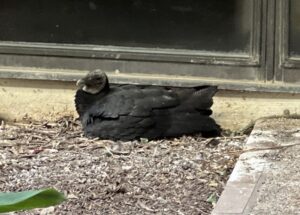
“[Black vultures are] great parents,” said Josef San Miguel, director of aviculture at the San Antonio Zoo. San Miguel should know. Black vultures are plentiful at the zoo, where he’s seen their devotion firsthand.
“[The nestlings are] very dependent, but it builds a very strong family group,” he said.
As omnivores, black vultures frequently dine on carrion, or animal carcasses, such as feral hogs, poultry, cattle, donkeys, raccoons, coyotes, opossums, striped skunks and armadillos. They will also catch small fish in shallow water or feed on floating carrion, according to the Cornell Lab.
“They can eat things that would kill other organisms,” Inglet said. “They have a very strong acid in their stomach. They can survive anthrax and botulism and other bacterial diseases that would kill other creatures.”
“Anything they ingest is going to turn into liquid, and so they regurgitate to the baby,” San Miguel said, adding that meat is their primary food of choice.
“They eat just about anything,” San Miguel said, adding that they even like popcorn and hot dogs.
San Antonio: A sought-out destination for black vultures
Black vultures are bountiful in San Antonio, likely because of the city’s moderate temperatures.
In fact, they live at the zoo throughout the year, San Miguel said.
“They love our giraffe area,” he said. “There’s a beautiful area — I call it Club Med — and they just love hanging around. They bathe all day. I mean, it’s just like a resort for them. There’s food, the sun and that beautiful pool out there [that] the giraffes share.”
They especially seem to enjoy the springtime, San Miguel said.
While it’s hard to determine if they migrate from San Antonio during the later part of the year, San Miguel said some seem to migrate further south, toward the coast.
Where’s the respect?
As members of the Cathartidae family, a group of seven species of New World vultures found in the Americas, black vultures are estimated to number in the millions, according to the Hawk Mountain Global Raptor Conservation.
Their role as nature’s cleanup crew is especially vital for the ecosystem.
“They’re kind of the Rodney Dangerfield of the bird world,” Inglet said. “They don’t get enough respect for what they do. They help clean up the environment of carcasses. We’d be knee-deep in dead things if the vultures were not active. The faster you take a carcass off the landscape, the less chance [diseases] spread.”
Despite some misconceptions, black vultures are quiet and go about the business of keeping the ecosystem clean.
“They don’t make a lot of noise,” San Miguel said. “They do play and you can see them enjoying themselves out here at our zoo at any given time. They don’t go after people for any reason. They’re just here doing a service and doing their thing every day.”
The baby vultures are here!
And the winning baby vulture names are…
The university community has spoken!
With more than 250 votes submitted, the top baby vulture names are... Rigor and Mortis.
Congratulations to the first person to submit the winning names, Robert Burns, MD candidate, Joe R. and Teresa Lozano Long School of Medicine. He will receive a lunch for two at the Panorama Buffet — a fine-dining experience at the Long Campus Academic Learning and Teaching Center — and a UT Health San Antonio-branded backpack.
The first runner-up — who submitted the names Rigor and Mortis after Robert Burns — is student Brianna Martinez. Frances Maldonado, CCRP, from the Department of Pediatrics, was the second runner-up with the second-most popular names — Floyd (Curl) and Louis (Pasteur). Both will receive a UT Health San Antonio-branded computer bag and Bluetooth speaker.
Watch this Honorable Mentions video to see other popular names that were submitted. Thank you to all who participated by submitting names, taking photos and voting!
Myth or fact: Diet and exercise habits that aid weight loss
As a new year comes into focus, weight loss and good health are often high on the list of goals for many

According to a recent Physicians Committee for Responsible Medicine/Morning Consult survey, nearly half of U.S. adults are planning to start a new diet as one of their 2025 resolutions. Of those surveyed, 40% plan to reduce calories, 26% aim to follow a low-carbohydrate diet and 25% intend to start a low-fat diet.
While it’s promising that many are motivated to do better for their health and well-being, weight loss is complex with many biological, social and behavioral factors involved. That’s why it’s key for those embarking on a weight-loss endeavor to distinguish between myths and facts.
Read on to learn how losing weight can be nuanced rather than cut-and-dried, with insights provided by Marzieh Salehi, MD, professor of medicine, Department of Medicine, Division of Diabetes.
1. Myth or fact? Skipping breakfast hinders weight loss.
 Answer: Veering toward myth. There are instances when skipping breakfast can create a pattern of skipping lunch and eating three times the calories in the evening, which is counterproductive. There are also studies suggesting that when skipping breakfast is associated with lower daily calorie consumption and healthier food intake, this can help with weight loss.
Answer: Veering toward myth. There are instances when skipping breakfast can create a pattern of skipping lunch and eating three times the calories in the evening, which is counterproductive. There are also studies suggesting that when skipping breakfast is associated with lower daily calorie consumption and healthier food intake, this can help with weight loss.
2. Myth or fact? All calories are the same whether from carbs, protein or fats.
 Answer: Myth. There is merit to the notion that not all calories are the same, but studies have shown that at the same level of calories, the quality of food matters and it’s not just about calories in and out. People who eat higher-quality calories from foods high in protein, nuts, legumes, fiber-rich foods, whole grains and foods with healthier fat have been shown to be better off than those eating lower-quality foods, because higher-quality foods can change appetite and satiety via various biological factors.
Answer: Myth. There is merit to the notion that not all calories are the same, but studies have shown that at the same level of calories, the quality of food matters and it’s not just about calories in and out. People who eat higher-quality calories from foods high in protein, nuts, legumes, fiber-rich foods, whole grains and foods with healthier fat have been shown to be better off than those eating lower-quality foods, because higher-quality foods can change appetite and satiety via various biological factors.
3. Myth or fact? Cardio workouts are best for weight loss.
 Answer: It depends. In general, cardio or aerobic exercise by itself may not induce weight loss. Recently, it has been shown that physical activities such as high-intensity training and a combination of aerobic exercise with isometric exercise — along with a high-quality diet and lower-calorie intake — may be more efficient in improving fat and lean body mass. High-intensity training is high bursts of any physical activity for 45 seconds to three minutes, repeated with cooling-down intervals as short as 10 minutes. Isometric exercises — like planks, wall squats and glute bridges — place tension on muscles without moving nearby joints. The bottom line is that the quality of one’s nutrient intake and the quality of exercises undertaken are key, as not all exercises can provide the same results.
Answer: It depends. In general, cardio or aerobic exercise by itself may not induce weight loss. Recently, it has been shown that physical activities such as high-intensity training and a combination of aerobic exercise with isometric exercise — along with a high-quality diet and lower-calorie intake — may be more efficient in improving fat and lean body mass. High-intensity training is high bursts of any physical activity for 45 seconds to three minutes, repeated with cooling-down intervals as short as 10 minutes. Isometric exercises — like planks, wall squats and glute bridges — place tension on muscles without moving nearby joints. The bottom line is that the quality of one’s nutrient intake and the quality of exercises undertaken are key, as not all exercises can provide the same results.
4. Myth or fact? Slow weight loss is better and helps keep weight off.
 Answer: Myth. It’s not the duration of the weight loss but the quality of the weight loss and the type of actions taken to achieve that loss. There was a randomized trial in which weight loss was induced in both a short and longer timeframe. The result was that the duration of time to lose weight didn’t seem to matter in regaining body weight. However, it should be noted that a huge rate of weight loss in a short amount of time may put some people at risk of some complications such as gallbladder disorder. Also, healthy food and water intake are necessary for safe, rapid weight loss, so those considering fast weight loss may want to consult with their physicians about their plans.
Answer: Myth. It’s not the duration of the weight loss but the quality of the weight loss and the type of actions taken to achieve that loss. There was a randomized trial in which weight loss was induced in both a short and longer timeframe. The result was that the duration of time to lose weight didn’t seem to matter in regaining body weight. However, it should be noted that a huge rate of weight loss in a short amount of time may put some people at risk of some complications such as gallbladder disorder. Also, healthy food and water intake are necessary for safe, rapid weight loss, so those considering fast weight loss may want to consult with their physicians about their plans.
5. Myth or fact? Body mass index, or BMI, is a good metric to determine if weight loss is needed.
 Answer: Myth. While BMI is one metric that is broadly used in clinical and research settings, it’s important to look at other metrics to get a broader picture. BMI — the ratio of one’s body weight over the body surface area — has served researchers well over time. But this metric doesn’t differentiate between lean mass, fat mass and bone mass. So, if someone has a larger bone mass, they may have the same body mass index as someone with more fat mass. For example, I’m currently conducting a National Institutes of Health-funded clinical trial to investigate the causes of diabetes and obesity in individuals with spinal cord injury and potential mitigatory effects of semaglutide. This medication is used to treat Type 2 diabetes and obesity. While people with spinal cord injury have a much lower body mass index, they have a much higher fat mass compared to able-bodied people, and they are at much higher risk of cardiometabolic complications because of that. The bottom line is that in individuals with BMI less than 40, other metrics — such as waist circumference or the ratio of waist circumference to hip circumference — are needed in addition to BMI to evaluate the extent of fat mass.
Answer: Myth. While BMI is one metric that is broadly used in clinical and research settings, it’s important to look at other metrics to get a broader picture. BMI — the ratio of one’s body weight over the body surface area — has served researchers well over time. But this metric doesn’t differentiate between lean mass, fat mass and bone mass. So, if someone has a larger bone mass, they may have the same body mass index as someone with more fat mass. For example, I’m currently conducting a National Institutes of Health-funded clinical trial to investigate the causes of diabetes and obesity in individuals with spinal cord injury and potential mitigatory effects of semaglutide. This medication is used to treat Type 2 diabetes and obesity. While people with spinal cord injury have a much lower body mass index, they have a much higher fat mass compared to able-bodied people, and they are at much higher risk of cardiometabolic complications because of that. The bottom line is that in individuals with BMI less than 40, other metrics — such as waist circumference or the ratio of waist circumference to hip circumference — are needed in addition to BMI to evaluate the extent of fat mass.
6. Myth or fact? Weight and metabolism are hereditary.
 Answer: Veers toward fact. There’s no question that genetic factors matter in weight loss, but there are other important dynamics to consider like behavior carried from one generation to another. It’s well-accepted that generation-to-generation transfer of inherited characteristics can include behavioral and biological factors like food insecurity and childhood trauma. Within one generation, early childhood events can have an effect later in life with manifestations like obesity, dementia and cognitive abnormalities.
Answer: Veers toward fact. There’s no question that genetic factors matter in weight loss, but there are other important dynamics to consider like behavior carried from one generation to another. It’s well-accepted that generation-to-generation transfer of inherited characteristics can include behavioral and biological factors like food insecurity and childhood trauma. Within one generation, early childhood events can have an effect later in life with manifestations like obesity, dementia and cognitive abnormalities.
7. Myth or fact? Having an early cutoff time for eating aids weight loss.
 Answer: Veers toward fact. There is a lot of research focusing on how circadian rhythm may improve the balance between one calorie in and one calorie out. Researchers have compared people who eat normally from 7 a.m. to 3 p.m. to people who eat from noon to 8 p.m. and it seems that having the earlier cut-off time is a bit more effective in short-term weight loss. In the clinical setting, when dealing with some glucose abnormality and diabetes control, doctors have noticed that patients who eat late have a much worse outcome in terms of glucose control. So, there may be merit to having an earlier cutoff time.
Answer: Veers toward fact. There is a lot of research focusing on how circadian rhythm may improve the balance between one calorie in and one calorie out. Researchers have compared people who eat normally from 7 a.m. to 3 p.m. to people who eat from noon to 8 p.m. and it seems that having the earlier cut-off time is a bit more effective in short-term weight loss. In the clinical setting, when dealing with some glucose abnormality and diabetes control, doctors have noticed that patients who eat late have a much worse outcome in terms of glucose control. So, there may be merit to having an earlier cutoff time.
8. Myth or fact? Fasting helps the rate of weight loss.
 Answer: Veers toward fact. There is merit to intermittent fasting for short-term weight loss, but how that translates into a long-term effect is still unknown. Depending on one’s goal, having a short-term intervention and then tying that with a mindful process for a much longer period may be durable. But as of now, all that is known is that fasting techniques such as intermittent fasting may have some short-term benefit.
Answer: Veers toward fact. There is merit to intermittent fasting for short-term weight loss, but how that translates into a long-term effect is still unknown. Depending on one’s goal, having a short-term intervention and then tying that with a mindful process for a much longer period may be durable. But as of now, all that is known is that fasting techniques such as intermittent fasting may have some short-term benefit.
Final thoughts: According to Salehi, before embarking on a new diet or exercise routine, consult with your physician to discuss any ongoing health issues and the best course of action to lose weight in a healthy way.
True, false or somewhere in between?
Read more in our myth-or-fact series of conversations with UT Health San Antonio faculty and care providers to test your knowledge about specific health concerns:
- Common assumptions about health
- Ear health and how ears work
- How to protect your eyes
- How to maintain good oral health
- What you can do to boost brain function
The community as the classroom: What School of Public Health students will learn
School of Public Health leaders identify seven unique attributes of the new Master of Public Health degree program and share how they define public health
This fall, several dozen students became part of history as the inaugural cohort of the university’s new Master of Public Health in Public Health Practice and Administration program, the first degree offering of The University of Texas School of Public Health San Antonio. But what will these students learn as they usher in an era of immersive research and learning, exploring effective public health solutions in partnership with local populations? Academic leaders share how this program is essential and unique for South Texas.
COMMUNITY-LED

I refer to this sixth school of our university as “The People’s School” because people are at the center of everything
that we will do. Our mission is community-driven. We think of our school as something integrated into the community from conception. That means we see an accountability of the school to the community, and we treat the community as equals in what we’re doing. We use words like co-contribution, co-learning and co-ownership to indicate the community is the classroom.
Within our tripartite mission of education, research and service, we see ourselves as a catalyst and facilitator that brings community stakeholders together and synergizes that effort to result in changing the health of the community as a whole.
One of our missions — education — is itself a primary social determinant of health overall because education gives you economic opportunities. We are building a curriculum that is flexible so that we can accommodate the work schedules of our students while also providing a pathway where they can receive applied practical experiences working with local organizations. These experiences are critical, as these organizations might serve as their future employers.
What is public health? Public health is about partnering with the wide fabric of community stakeholders on leveraging assets and addressing concerns that determine the well-being of all individuals. Our missions of research and service revolve around working with community partners to identify and fine-tune the solutions that already exist for achieving success. This means working with The University of Texas at San Antonio, the Metropolitan Health District, Bexar County’s Preventative Health and Environmental Services Department and with a range of faith-based and non-governmental organizations and non-health care-related services like transportation, housing, utilities and law enforcement.
SERVICE-FOCUSED

Our strategic vision for this program and for our school emphasizes the importance of service that meaningfully impacts the community we are serving. To that purpose, our curriculum engages students in coursework related to public health practice and administration that adheres to the guidelines and criteria set by the Council on Education for Public Health.
We are excited about our multidisciplinary faculty and advisers who will assist students and mentor them through the process not only of what they learn in the classroom, but also as they translate this knowledge into practical terms when they engage in their applied practice experience working with community organizations.
Among the council’s guidelines we’re following is to require each student to complete a capstone learning experience or discovery-based paper. This takes place in the student’s final year after being exposed to various knowledge bases in the classroom and completion of their internship. This integrative learning experience equips students to synthesize their didactic classroom learning and experiential learning within the community to prepare them for their future work as public health practitioners.
What is public health? We know that where you live, your income, your education and your access to health care play a big role in your health outcomes. In fact, the American Public Health Association has identified that your ZIP code could influence your lifespan by as much as 15 years. The science is clear that poverty and poor health often go hand in hand, and to advance our nation’s health, growing income inequality also must be addressed. So, we must shift the main focus of our health system from one that focuses on treating illnesses to one that focuses strongly on prevention. That is what public health is about.
STORY-DRIVEN

All students will have foundational competencies in all areas of public health and will pick an area in which they want to specialize. Within that context, we are the department that will help students accomplish their work by incorporating methods, statistics and epidemiology.
There can be a tendency to lean very heavily toward the numbers, the quantitative. But the qualitative piece really gives a story to those numbers. Most people tend to gravitate toward one or the other. Instead of picking their favorite tool, I want students to learn to pick the right tool or the right combination that addresses the problem with which they are dealing.
One way to approach a new problem is to start with qualitative methods, such as having focus groups and doing interviews where students go to the community and learn the community’s language and how they’re talking about a problem. Doing qualitative research with smaller numbers of people can inform how we can then conduct a survey to capture larger populations in a meaningful way because we’ve learned the right ways to measure things. This collection of qualitative and quantitative information can inform interventions, which can then inform policy.
One example of how we’ve managed to move qualitative and quantitative information to policy is with policies for legal-age requirements for the purchase of alcohol. In the 1980s, to address the problem of how much alcohol was in high schools, we moved the legal age to buy alcohol to 21. The result was a significant reduction in adolescent drinking and drunk driving accidents. More recently, we’ve started to do this with tobacco. Just a few years ago, Texas passed a law that you need to be 21 to buy tobacco. Yes, those under 21 still get access to these things, but at much lower rates.
What is public health? Public health is not about scaling up an individual medical intervention or treatment. This is much more about structural change. It’s about prevention and intervention — intervening further upstream so that we are focused not on treating a chronic illness, but on preventing it from happening.
EVIDENCE-BASED

The two broad areas of interest for this department are environmental health, with a focus on developing preventive strategies to improve the quality of our environment and mitigate the health effects of pollution and contaminants on communities, and occupational health, with a focus on developing strategies to promote a safe and healthy work environment. Our department is also interested in policy and advocacy, studying how environmental and occupational health policies contribute to developing regulations and advocating for policies that promote health and well-being.
For example, if you think about heat waves, those affect communities and certainly affect workers, including agricultural workers and construction workers. We need to protect these workers and their communities, and there are a lot of things that we can do, like having shade for breaks. We need to focus on the things a community can do something about.
Within that context, our school will assist in the transformation of South Texas through several strategies:
- Engaging with local communities to understand their unique health needs and challenges and how to tailor interventions and strategies to the specific context of South Texas.
- Conducting research on the health issues prevalent in the region, monitoring trends and identifying emerging health threats so the appropriate evidence-based interventions can be developed.
- Promoting and delivering education and training to the current and future workforce of public health professionals.
- Addressing the health disparities present in the region to ensure equitable health outcomes for all
- Strengthening the region’s capacity to respond to crises, be they natural disasters or public health emergencies, and ensuring the safety and well-being of communities in the region.
What is public health? On a broad level, public health aims to address the upstream causes, the so-called social determinants of health, or “the causes of the causes.” In that effort, public health professionals work across disciplines, sectors, domains and communities, teaching and applying environmental and occupational health, epidemiology, biostatistics, health policy and management, social and behavioral sciences and more to create conditions that support health and well-being on a large scale.
PARTNERSHIP-ALIGNED

This department is at the intersection of public health and health care. While not everyone knows what public health is, almost everyone understands what medical care or health care encompasses. Our mission is to advance public health through improved access to care, enhanced delivery of health care services and better population health outcomes overall and specifically for people in South Texas.
We focus on three main areas:
- Provision of health care services, including programs to evaluate and enhance availability of needed care, quality of care, health outcomes, health care costs and the health care workforce.
- Administration of organizations and systems that deliver health care services or support individuals and their families in receiving needed health care.
- Policies to advance population health at local, regional, national and international levels.
This includes working to understand and address issues including health disparities, insurance, health care financing, experience of care, social determinants of health, health care leadership and medical technology assessment.
To address these goals, we’re committed to partnering with community-based organizations, government agencies, military services, academic institutions, health care organizations, insurers, private companies and other groups involved in health care.
What is public health? Public health is a process where members of the community and organizations supporting health and health care work together to improve population health outcomes. Because so many factors can influence the health of populations, and different factors are important for improving the health of different population groups, no one entity can do this alone. By working with partners, we can improve population health and enhance the value of health services, programs and policies.
SOCIETY-CENTRIC

I describe the focus of this department as covering everything from womb to tomb. We want to help people have healthier lives where they work, play, learn, pray and age. We consider every aspect of society in public health and the influences that impact how people behave, how policies are instituted and how communities and organizations are developed and evolve to help people pursue what’s best for them.
By working collaboratively with and learning from the community, we can better understand different factors that influence what’s happening within a community or population.
How our communities are organized influences how we live and what we can do. In theory, policies are based on what people want and desire. Public health, in part, helps bring awareness so people can voice their concerns and say what they want to see in the policies put in place by our policymakers.
Public health advocacy is important to help ensure those policies prioritize a healthy default for everyone so that workers aren’t spending 10 hours sitting or standing, and that neighborhoods have access to nutritious food.
What is public health? Public health is difficult for many to understand because it can be hard to measure. How do you measure something that’s not happening? Because if we are successful, there won’t be high rates of diabetes or kids smoking cigarettes. The importance of public health is helping people better understand that what happens to you impacts your neighbor. We don’t live in a vacuum. We live with each other, and how we live influences everyone else.
POLICY-ORIENTED

Policy development is one of the core functions of public health, which includes assessment and assurance. When most people think about policy development, they think of politicians. They may not think about zoning, where liquor stores are located or who gets a tobacco license. They may not think about the occupational health space such as who must wear protective equipment, why they must wear it or how long it must be worn. Public policy applies to everything from zoning to ordinances around trash collection.
During the COVID-19 pandemic, when hospitals were at and beyond capacity, we all came to understand the need to prioritize public health. What we quickly learned was that in a situation where the majority of a population is at risk of illness or exposure to illness, it can cripple a health services system if that system wasn’t made to deal with that level of burden.
What ultimately worked was adopting public health measures, like wearing masks, quarantining and all the other preventative things that help to ease the burden on the system. Those were policy decisions, and coming to those kinds of decisions usually requires dealing with various stakeholders and understanding the risk associated with action or inaction.
The curriculum we’ve designed at the UT School of Public Health San Antonio is purposed around training students to understand their role as conveners of conversations around issues that impact health. It’s been refined over time to focus on ensuring that students who will graduate from our program are equipped with the tools they’ll need to ask really smart questions to help solve problems and help people reach healthy outcomes.
What is public health? Public health is about creating conditions where everyone can be healthy. No one can change something alone, but together we can do a whole lot. And that is the point of public health. It is galvanizing people to engage in conversations that lead to solutions that impact our health and the health of the world around us.
More programming to come
In addition to the inaugural Master of Public Health program launching this fall, a second dual degree program is scheduled to begin in summer 2025. The program will offer a joint Doctor of Medicine from the Joe. R. and Teresa Lozano Long School of Medicine and a Master of Public Health in Health Systems from the UT School of Public Health San Antonio. A doctoral program will follow within several years.
Baby vultures born at the university prepare to leave the roost
On any given day over the past few months, at least half a dozen people congregated at the doors across from the Dental Hygiene office in the Dental School Building to admire two black vulture nestlings that had transformed in the span of just a few weeks.

Once covered in whitish tufts of feathers, the sprawling birds with extensive black wings and white downy feathers circling their bare heads were inching toward adulthood. But despite their breakneck growth, they still retained a look of innocence that hinted at their recent entrance into the world.
The two nestlings were the newest chicks to hatch to a family of vultures nesting on campus the past four years. The private corner of the courtyard across from the Dental Hygiene office was likely chosen because of its shade and seclusion and has been used by the same parents that have successfully reared their young there over the years.
“Birds are very loyal to a place that works,” said Richard Gibbons, Audubon Society director of Conservation, Texas. “They need a place where predators aren’t likely to find them, because they are often on the ground. Sometimes they’ll find a little hollow in a tree, but usually they’re ground nesters.”
A new home
Initially thought to nest at the Professional Administrative Resource Center Building, the black vultures claimed their newest nesting site near the entry doors to the Dental School in early 2020, just as the COVID-19 pandemic emerged, said Jeffrey Patterson, MBA, executive director, Facilities Management and Operations. The site fit the criteria that most black vultures seek: dark cavities such as caves, hollow trees, abandoned buildings, brush piles, thickets and stumps, according to the Cornell Lab of Ornithology.
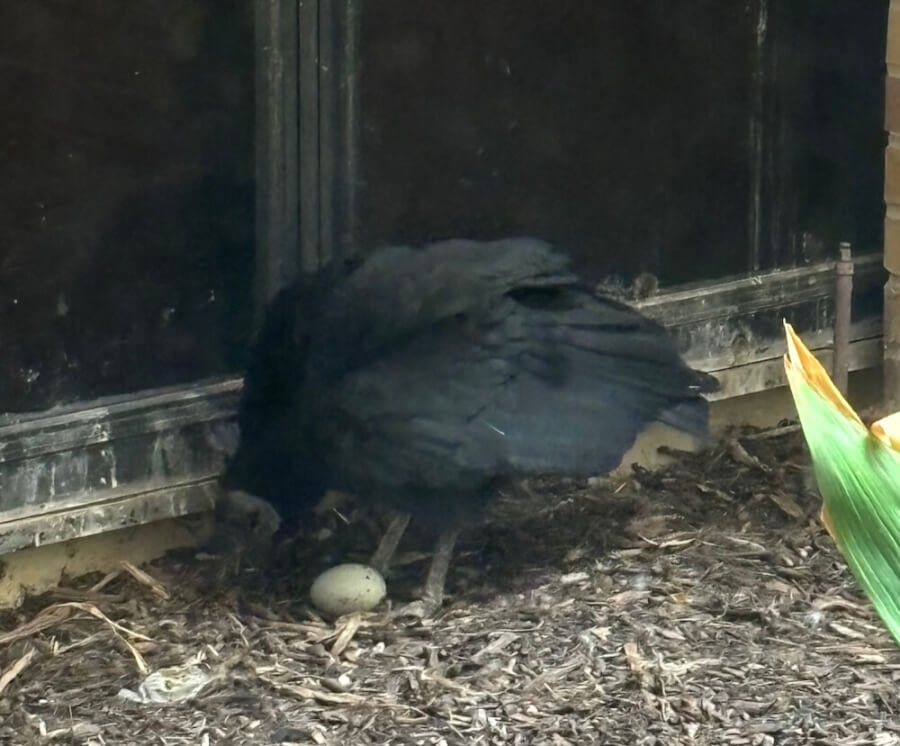
There, the mother laid her eggs and called the site home. Since then, the black vultures have arrived at this site around January each year.
To preserve the pristine location, university staff went to great lengths not to disturb the nesting site during a months-long roof renovation at the Dental School in 2023. Facilities Management worked closely with Compliance to ensure that the construction would not impact the birds, Patterson said.
“Fortunately, the work did not impact the flight pattern of the hatchlings,” he said.
Circle of life
While black vultures tend to lay one to three eggs — which can be bluish white or pale green — the mother vulture on campus has been consistent in laying two eggs each year, Patterson said.
Both the mother and father vultures take turns incubating the precious eggs — a common practice that allows one parent to protect the eggs while the other forages for food. As monogamous birds, the black vultures remain with their mates throughout the year.
Typically, the incubation period for black vultures is 37–48 days, according to Stan Tekiela’s 2004 “Birds of Texas Field Guide.” And, according to the Cornell Lab of Ornithology, once the chicks hatch — covered in thick yellowish or pinkish down — they are dependent on their parents.
The eggs typically hatch by March or early April, Patterson said. The latest brood of two was welcomed into the world this April.
Black vulture chicks typically remain nestlings that do not venture away from the nest for 80–90 days. Parents feed their young for up to eight months after fledging, or when the vultures develop wings large enough to fly, according to the Cornell Lab of Ornithology.
“Vultures are definitely learners. They are altricial and get a lot of parental care,” Gibbons said. “It takes some time and practice for them to learn to fly. When that time comes, if they were already moving around, they’ll probably start jumping up and down and really flap those wings, getting the feel for it. It’s not a super easy instinct.”
In recent weeks, the newest nestlings have been perfecting their flying techniques near the back steps of the Dolph Briscoe Jr. Library as well as in front of the building.
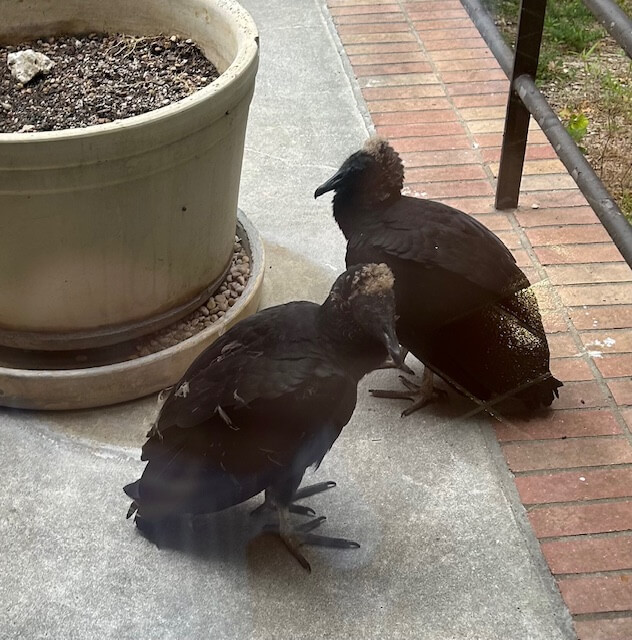
“It’s really funny, because you watch [the nestlings] work at the back of the [library] building where the little seating area is, and they get a little better at [flying],” said Administrative Assistant Michele Couret, who has worked at both the Dental School and Dolph Briscoe Jr. Library buildings, where the birds often gather. “They go over the top of the library to the front area and they’ll sit on the railings in the morning and kind of watch the students walk up. And if the students aren’t paying attention, or if they’re looking at their phone, they never even notice that they passed this two-foot bird.”
Each year, after the brood gains their stride, the family leaves the Dental Hygiene courtyard at the end of June or early July and can be spotted on the back side of the breezeway, according to a faculty member working in the Dental Hygiene office.
Once the brood enters adulthood, they can reach the size of a heron, mallard or herring gull, with broad wings that span at least 4.5 feet, according to The National Audubon Society. Their flying technique is distinctive, with strong wingbeats followed by short glides, giving them a batlike appearance, according to the Cornell Lab of Ornithology.
Close-knit families
Slightly smaller than the red-headed turkey vulture, black vultures — also called black buzzards — are more sociable than the turkey vultures, notes author Tkiela.
They are very loyal to their family. These close-knit ties are particularly advantageous as they forage for food. Because they lack a good sense of smell, they hover above the more aroma-sensitive turkey vulture and follow the vulture to carrion, or an animal’s carcass. As the turkey vulture swoops in and begins his meal, the solitary bird may be edged out by a family of black vultures arriving soon after, according to the Cornell Lab of Ornithology.

In addition to sharing meals, black vulture families also enjoy allopreening, or grooming one another. “It’s hard for birds to clean their own head,” Gibbons said. “They may help each other out — ‘oh, you missed a spot back here.’ That was always surprising to me, just how much they like to sit around and preen and take care of each other.”
A front-row seat to nature
Many members of the university community have delighted in having a firsthand look as the hatchlings progress and mature each year.
Some years, university employees have even named the hatchlings. In 2020, the hatchlings were named Passion and Purpose, and in 2022, Sol and Luna, the faculty member recalled.
“Many people come and take breaks to visit them daily, to check on the babies and take pictures,” the faculty member said. “As the babies get bigger, they start to venture into the plants and sometimes you can’t see them and I can hear people say, ‘Oh no! Where are the babies?’ But the babies peek out and I can hear the excitement [when they find] them.”
Roberta Johnson, library clerk assistant-associate, said it’s been a pleasure watching the baby vultures mature.
“I think it’s kind of neat to see them grow up and go on their way,” she said. “Not many people get that opportunity.”
Benefiting the ecosystem
While black vultures may spur some negative associations because they are often spotted at sites of dead animals, they help clean the ecosystem and protect it from diseases. They are, in effect, nature’s cleanup crew.
“Try to understand wildlife for what they are and for what their ecology demands of them,” Gibbons said. “Once you understand what their lives are, then you can really appreciate the way that they’re shaped by nature to have these big nostrils and these bare heads. All these things that may seem weird or strange have a purpose. Once you think of it like that, I think [black vultures] will earn the appreciation of anyone who’s willing to pay attention. There are cultures that highly revere vultures, and we should be one of them.”
Click here for eight interesting facts about black vultures.
Editor's note: If you missed seeing the nestlings this year, stay tuned until early 2025.




